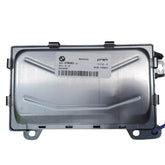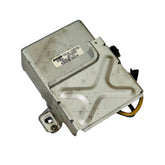The Toyota ECU (Engine Control Unit) is the brain of your vehicle, controlling engine performance, fuel efficiency, and emissions. When an issue occurs, the ECU generates Diagnostic Trouble Codes (DTCs) to help identify the problem. These codes can indicate anything from minor sensor malfunctions to serious engine troubles.
Understanding Toyota ECU error codes and knowing how to fix them can save you time and money while preventing major mechanical failures. In this blog, we’ll explain the most common Toyota ECU error codes, their meanings, and how to resolve them.
How to Retrieve Toyota ECU Error Codes
Before fixing an ECU error, you need to retrieve the error code. Follow these steps:
-
Use an OBD-II scanner and connect it to the OBD-II port (usually under the dashboard).
-
Turn the key to the "ON" position without starting the engine.
-
Read the error code displayed on the scanner.
-
Compare the code with Toyota’s official database to understand the issue.
Once you have the code, you can diagnose and fix the problem accordingly.
Common Toyota ECU Error Codes and How to Fix Them
1. P0300 – Random/Multiple Cylinder Misfire Detected
What It Means:
-
This code indicates that multiple engine cylinders are misfiring, leading to poor performance, rough idling, and increased fuel consumption.
Possible Causes:
- Faulty spark plugs or ignition coils
- Clogged fuel injectors
- Low fuel pressure
- Vacuum leaks
Fixes:
- Replace worn-out spark plugs and ignition coils.
- Clean or replace clogged fuel injectors.
- Check fuel pressure and fuel pump operation.
- Inspect vacuum hoses for leaks and repair if necessary.
2. P0420 – Catalyst System Efficiency Below Threshold (Bank 1)
What It Means:
-
The catalytic converter is not performing efficiently, which may cause increased emissions.
Possible Causes:
-
Faulty oxygen (O2) sensors
-
A failing catalytic converter
-
Exhaust system leaks
-
Engine misfires
Fixes:
-
Replace malfunctioning oxygen sensors.
-
Inspect and replace the catalytic converter if needed.
-
Check the exhaust system for leaks and repair them.
-
Address any misfire issues that could be causing excess emissions.
3. P0171 – System Too Lean (Bank 1)
What It Means:
-
The ECU detects that the engine is running too lean (not enough fuel compared to air intake).
Possible Causes:
-
Dirty or faulty mass airflow (MAF) sensor
-
Vacuum leaks
-
Clogged fuel filter
-
Weak fuel pump
Fixes:
-
Clean or replace the MAF sensor.
-
Inspect and seal any vacuum leaks.
-
Replace the fuel filter.
-
Test the fuel pump for proper pressure.
4. P0500 – Vehicle Speed Sensor Malfunction
What It Means:
-
There is an issue with the Vehicle Speed Sensor (VSS), which affects speedometer accuracy and ABS functionality.
Possible Causes:
-
Faulty or damaged speed sensor
-
Broken wiring or poor connection
-
Faulty ABS module
Fixes:
-
Replace the damaged or failing speed sensor.
-
Inspect and repair wiring connections.
-
If ABS-related, diagnose the ABS module for further issues.
5. P1604 – Startability Malfunction
What It Means:
-
This code appears when the vehicle has difficulty starting, usually due to battery or fuel system issues.
Possible Causes:
-
Weak battery or alternator failure
-
Clogged fuel injectors
-
Ignition system failure
Fixes:
-
Charge or replace the battery if weak.
-
Clean or replace clogged fuel injectors.
-
Inspect the ignition system for faulty components.
What to Do If an ECU Error Code Appears
If your Toyota ECU displays an error code, follow these steps:
-
Read the Error Code – Use an OBD-II scanner to retrieve the code.
-
Research the Code – Identify the issue and possible solutions using this guide.
-
Perform Basic Fixes – Replace faulty parts, clean sensors, or check for leaks.
-
Reset the ECU – Clear the error code using the scanner and test-drive the vehicle.
-
Seek Professional Help – If the issue persists, consult a certified Toyota technician.
How to Prevent Toyota ECU Errors
Regular maintenance can help prevent ECU-related issues. Here are some key tips:
-
Perform regular oil changes to keep the engine clean.
-
Inspect and clean MAF sensors, O2 sensors, and throttle position sensors.
-
Use high-quality fuel to prevent carbon buildup in injectors and combustion chambers.
-
Keep the battery in good condition to avoid electrical issues.
-
Stay updated on Toyota recall notices for ECU-related updates.
Why ECU Maintenance Matters
A properly functioning Toyota ECU ensures:
-
Improved Fuel Efficiency – The ECU optimizes fuel injection, improving gas mileage.
-
Better Engine Performance – A healthy ECU means smooth acceleration and consistent power delivery.
-
Lower Emissions – An efficient ECU reduces carbon emissions and ensures compliance with environmental regulations.
-
Prevention of Costly Repairs – Catching and fixing small issues early prevents major engine damage.
At Automan, we specialize in high-quality pre-owned Toyota ECUs, ensuring your vehicle’s computer system functions optimally. Whether you need a replacement Toyota ECU or expert advice on troubleshooting error codes, we have you covered.
Frequently Asked Questions (FAQs)
1. Can I drive my Toyota with an ECU error code?
It depends on the code. Some minor issues, like a loose gas cap, won’t impact drivability, but codes related to the engine, transmission, or emissions system should be addressed immediately.
2. How much does it cost to fix a Toyota ECU error code?
The cost varies depending on the issue. Sensor replacements can range from $50 to $300, while a new Toyota ECU may cost $500 to $1,000.
3. Can I reset the ECU myself?
Yes, you can reset the ECU using an OBD-II scanner or by disconnecting the battery for a few minutes. However, resetting without fixing the underlying issue will likely cause the error code to return.
4. What happens if my Toyota ECU fails completely?
A failing ECU can cause engine stalling, poor fuel economy, and erratic performance. In such cases, replacing the ECU is necessary to restore proper vehicle function.






